PIPEVINE SWALLOWTAIL Battus philenor
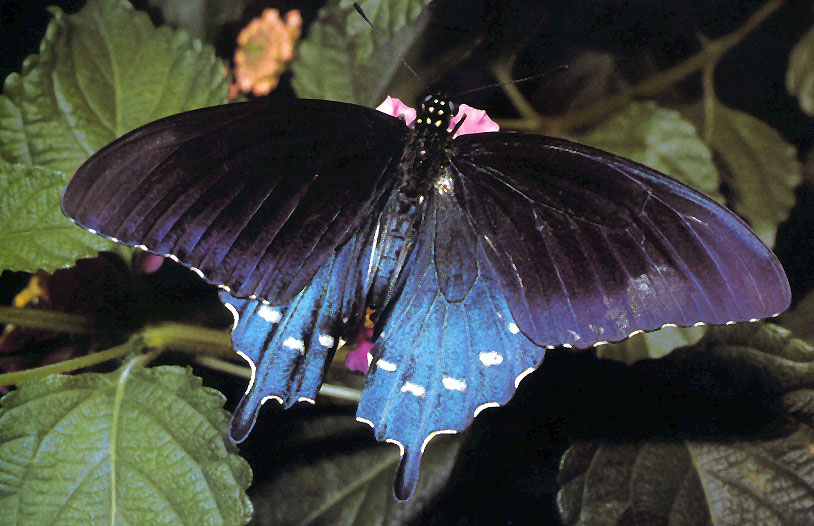 If you ever see a Pipevine Swallowtail in
your garden, you definitely will notice it. They have the most beautiful blue
iridescent hindwing. you will see in North America. It really is an
attention-getter. It's also been called the Blue Swallowtail because of this blue
iridescence. Wing span is 2 3/4- 3 3/8 inches. The underside of the hind wing
has one row of seven orange spots in an iridescent blue field. It's easy to
distinguish from the Spicebush and Black Swallowtails if you remember that the Spicebush
and Black have two rows of orange spots. This foul-tasting butterfly is mimicked by
six other butterflies in the eastern US, including four that live in Florida (Spicebush
Swallowtail, the black form of the Eastern Tiger Swallowtail, the female Black
Swallowtail, and the Red-spotted Purple).
If you ever see a Pipevine Swallowtail in
your garden, you definitely will notice it. They have the most beautiful blue
iridescent hindwing. you will see in North America. It really is an
attention-getter. It's also been called the Blue Swallowtail because of this blue
iridescence. Wing span is 2 3/4- 3 3/8 inches. The underside of the hind wing
has one row of seven orange spots in an iridescent blue field. It's easy to
distinguish from the Spicebush and Black Swallowtails if you remember that the Spicebush
and Black have two rows of orange spots. This foul-tasting butterfly is mimicked by
six other butterflies in the eastern US, including four that live in Florida (Spicebush
Swallowtail, the black form of the Eastern Tiger Swallowtail, the female Black
Swallowtail, and the Red-spotted Purple).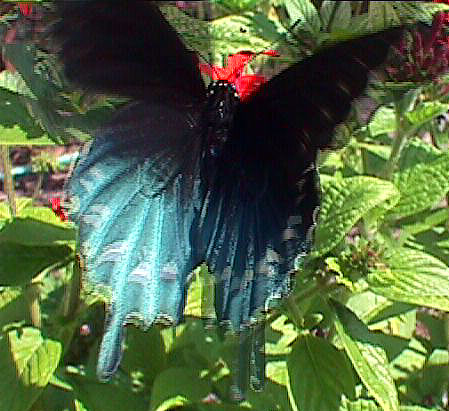
In earlier times this species seems to have been more common in the Northeast, perhaps
because ornamental pipevines were common garden plants in Victorian times. The
growth of butterfly gardening may bring them back!!! This has caused their range to
expand.
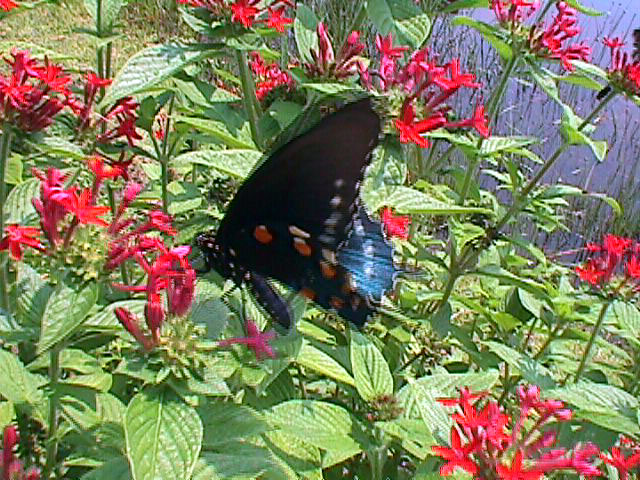 Eggs are clustered, and rust
colored, and laid on the undersides of host plants. Mature caterpillar is rust-black
with black or red projections, longest on head. It's quite distasteful to birds
because of chemicals contained in the leaves of the pipevines Aristolochia on
which it feeds. Duchman's pipe Aristolochia macrophylla, along with native
hosts A. durior, A. reticulata, and A. serpentaria (or snakeroot) are host
plants. Chrysalis is lavender to greenish-yellow or pale brown; has sculptured
curves, angles, and
Eggs are clustered, and rust
colored, and laid on the undersides of host plants. Mature caterpillar is rust-black
with black or red projections, longest on head. It's quite distasteful to birds
because of chemicals contained in the leaves of the pipevines Aristolochia on
which it feeds. Duchman's pipe Aristolochia macrophylla, along with native
hosts A. durior, A. reticulata, and A. serpentaria (or snakeroot) are host
plants. Chrysalis is lavender to greenish-yellow or pale brown; has sculptured
curves, angles, and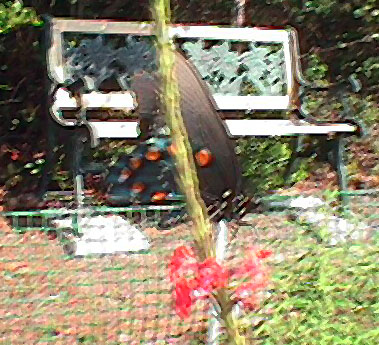 horns. Butterflies nectar on
thistles, bergamot, lilac, viper's bugloss, azaleas, phlox, teasel, dame's-rocket,
lantana, petunias, verbina's, lupines, yellow star thistle, California buckeye,
honeysuckle, milkweed, buddleia, orchids, penta, and porterweed. In my garden, they
LOVE coral porterweed. They prefer open woodlands, canyons, meadows. fields,
gardens. streamsides, orchards and roadsides.
horns. Butterflies nectar on
thistles, bergamot, lilac, viper's bugloss, azaleas, phlox, teasel, dame's-rocket,
lantana, petunias, verbina's, lupines, yellow star thistle, California buckeye,
honeysuckle, milkweed, buddleia, orchids, penta, and porterweed. In my garden, they
LOVE coral porterweed. They prefer open woodlands, canyons, meadows. fields,
gardens. streamsides, orchards and roadsides.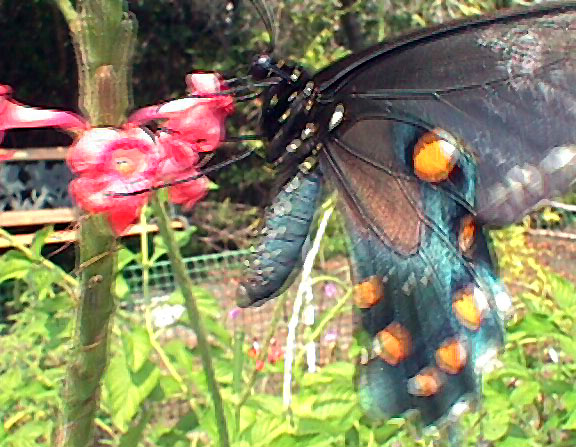
As you can see from my pictures, they are not easy to photograph. The wings are
in constant motion, so you can't get a 'still' shot. The photographer who took the
first pic at the top is better than I am! And luckier ;-)
 Back to the butterflies
Back to the butterflies
 If you ever see a Pipevine Swallowtail in
your garden, you definitely will notice it. They have the most beautiful blue
iridescent hindwing. you will see in North America. It really is an
attention-getter. It's also been called the Blue Swallowtail because of this blue
iridescence. Wing span is 2 3/4- 3 3/8 inches. The underside of the hind wing
has one row of seven orange spots in an iridescent blue field. It's easy to
distinguish from the Spicebush and Black Swallowtails if you remember that the Spicebush
and Black have two rows of orange spots. This foul-tasting butterfly is mimicked by
six other butterflies in the eastern US, including four that live in Florida (Spicebush
Swallowtail, the black form of the Eastern Tiger Swallowtail, the female Black
Swallowtail, and the Red-spotted Purple).
If you ever see a Pipevine Swallowtail in
your garden, you definitely will notice it. They have the most beautiful blue
iridescent hindwing. you will see in North America. It really is an
attention-getter. It's also been called the Blue Swallowtail because of this blue
iridescence. Wing span is 2 3/4- 3 3/8 inches. The underside of the hind wing
has one row of seven orange spots in an iridescent blue field. It's easy to
distinguish from the Spicebush and Black Swallowtails if you remember that the Spicebush
and Black have two rows of orange spots. This foul-tasting butterfly is mimicked by
six other butterflies in the eastern US, including four that live in Florida (Spicebush
Swallowtail, the black form of the Eastern Tiger Swallowtail, the female Black
Swallowtail, and the Red-spotted Purple).
 Eggs are clustered, and rust
colored, and laid on the undersides of host plants. Mature caterpillar is rust-black
with black or red projections, longest on head. It's quite distasteful to birds
because of chemicals contained in the leaves of the pipevines Aristolochia on
which it feeds. Duchman's pipe Aristolochia macrophylla, along with native
hosts A. durior, A. reticulata, and A. serpentaria (or snakeroot) are host
plants. Chrysalis is lavender to greenish-yellow or pale brown; has sculptured
curves, angles, and
Eggs are clustered, and rust
colored, and laid on the undersides of host plants. Mature caterpillar is rust-black
with black or red projections, longest on head. It's quite distasteful to birds
because of chemicals contained in the leaves of the pipevines Aristolochia on
which it feeds. Duchman's pipe Aristolochia macrophylla, along with native
hosts A. durior, A. reticulata, and A. serpentaria (or snakeroot) are host
plants. Chrysalis is lavender to greenish-yellow or pale brown; has sculptured
curves, angles, and horns. Butterflies nectar on
thistles, bergamot, lilac, viper's bugloss, azaleas, phlox, teasel, dame's-rocket,
lantana, petunias, verbina's, lupines, yellow star thistle, California buckeye,
honeysuckle, milkweed, buddleia, orchids, penta, and porterweed. In my garden, they
LOVE coral porterweed. They prefer open woodlands, canyons, meadows. fields,
gardens. streamsides, orchards and roadsides.
horns. Butterflies nectar on
thistles, bergamot, lilac, viper's bugloss, azaleas, phlox, teasel, dame's-rocket,
lantana, petunias, verbina's, lupines, yellow star thistle, California buckeye,
honeysuckle, milkweed, buddleia, orchids, penta, and porterweed. In my garden, they
LOVE coral porterweed. They prefer open woodlands, canyons, meadows. fields,
gardens. streamsides, orchards and roadsides.